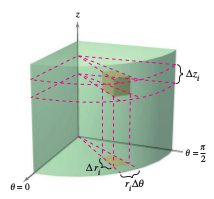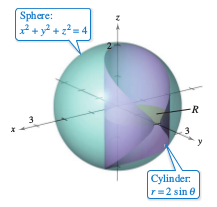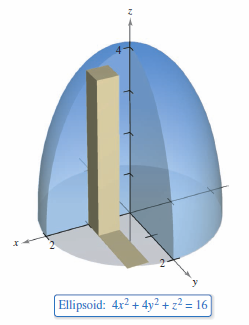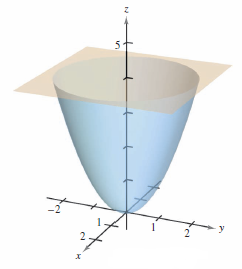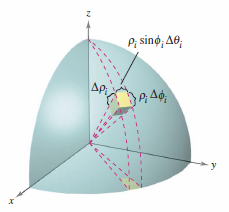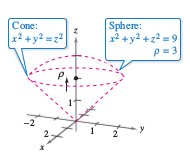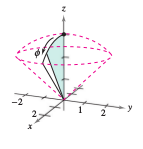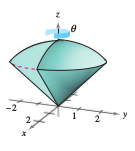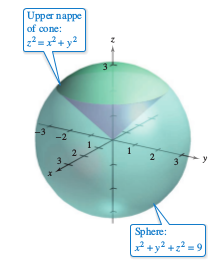Calculus III 14.07 Triple Integrals in Other Coordinates
| Previous | Calculus III 14.06 Triple Integrals and Applications |
| Next | Calculus III 14.08 Jacobian Variables |
Contents
14.7 Triple Integrals in Other Coordinates
- Write and evaluate a triple integral in cylindrical coordinates.
- Write and evaluate a triple integral in spherical coordinates.
Triple Integrals in Cylindrical Coordinates
|
|
Many common solid regions, such as spheres, ellipsoids, cones, and paraboloids, can yield difficult triple integrals in rectangular coordinates. In fact, it is precisely this difficulty that led to nonrectangular coordinate systems. This section discusses how to use cylindrical and spherical coordinates to evaluate triple integrals. Recall from Section 11.7 that the rectangular conversion equations for cylindrical coordinates are
An easy way to remember these conversions is to note that the equations for \(x\) and \(y\) are the same as in polar coordinates and \(z\) is unchanged. In this coordinate system, the simplest solid region is a cylindrical block determined by
as shown in Figure 14.7.1. To obtain the cylindrical coordinates for a triple integral, consider a solid region \(Q\) whose projection \(R\) onto the \(xy\)-plane can be described in polar coordinates. Such as,
and
If \(f\) is a continuous function on the solid \(Q\), the triple integral for \(f\) over \(Q\) can be written as
where the double integral over \(R\) is evaluated in polar coordinates. In other words, \(R\) is a plane region that is either \(r\)-simple or \(\theta\)-simple. If \(R\) is \(r\)-simple, then the iterated form for the triple integral in cylindrical form is
As in cartesian triple integration, there are six possible orders,
To visualize a particular integration order, picture the iterated integral as three sweeping motions—each adding another dimension to the solid. For example, in the order \(dr \: d\theta \: dz\), the first integration occurs in the \(r\)-direction as a point sweeps out a ray, as shown in Figure 14.7.2. Then, as \(\theta\) increases, the line sweeps out a sector, as shown in Figure 14.7.3. Finally, as \(z\) increases, the sector sweeps out a solid wedge, as shown in Figure 14.7.4. |
Example 14.7.1 Finding Volume in Cylindrical Coordinates
|
|
Find the volume for the solid region \(Q\) cut from the sphere
as shown in Figure 14.7.5.
Let \(R\) be the circular projection for the solid onto the \(r\theta\)-plane. Then the bounds on \(R\) are
The volume for \(Q\) is
|
Example 14.7.2 Finding Mass in Cylindrical Coordinates
|
|
Find the mass for an ellipsoid \(Q\) given by
lying above the \(xy\)-plane, as shown in Figure 14.7.6. The density at any point in the solid is proportional to the distance between the point and the \(xy\)-plane.
where \(k\) is the density constant. The ellipsoid's bounds are
and
|
Example 14.7.3 Finding the Inertia Moment
|
|
Find the inertia moment about the symmetric axis for the solid \(Q\) bounded by the paraboloid
and the plane
as shown in Figure 14.7.7. The density at any point is proportional to the distance between the point and the \(z\)-axis.
Therefore, the inertia moment about the \(z\)-axis is
Integration in cylindrical coordinates is useful when factors involving \(x^{2}+y^{2}\) appear in the integrand so that will be done here. The bounds in cylindrical coordinates are
|
Triple Integrals in Spherical Coordinates
|
|
Triple integrals involving spheres or cones are often easier to evaluate by converting to spherical coordinates. Recall from Section 11.7 that the cartesian conversion equations for spherical coordinates are
In spherical coordinates the simplest region is a spherical block determines by
where \(\rho_{1} \geqslant 0, \: \theta_{2} - \theta_{1} \leqslant 2 \pi\), and \(0 \leqslant \phi_{1} \leqslant \phi_{2} \leqslant \pi\), as shown in Figure 14.7.8. If \((\rho, \theta, \phi)\) is a point inside a spherical block, then the block's volume is approximated by \(\Delta V_{i} \approx \rho_{i}^{2} \sin \phi_{i} \Delta \rho_{i} \Delta \phi_{i} \Delta \theta_{i}\). |
Definition 14.7.1 Volume In Spherical Coordinates
If \(f\) is integrable over a solid region \(Q\) in spherical coordinates. The formula for the volume is
- $$ \int \int_{Q} \int f(x,y,z) \: dV = \int_{\theta_{1}}^{\theta_{2}} \int_{\phi_{1}}^{\phi_{2}} \int_{\rho_{2}}^{\rho_{2}} f(\rho \sin \phi \cos \theta, \rho \sin \phi \sin \theta, \rho \cos \phi) \rho^{2} \sin \phi \: d\rho \: d \phi \: d \theta $$
Like triple integrals in cylindrical coordinates, triple integrals in spherical coordinates are evaluated with iterated integrals. As with cylindrical coordinates, the integration order can be viewed as three sweeping motions—each adding another dimension to the solid. For instance, the iterated integral
- $$ \int_{0}^{2 \pi} \int_{0}^{\pi/4} \int_{0}^{3} \rho^{2} \sin \phi \: d\rho \: d \phi \: d \theta,$$
which is shown in Figure 14.7.9, Figure 14.7.10, and Figure 14.7.11.
Example 14.7.4 Finding Volume in Spherical Coordinates
|
|
Find the volume for the solid region \(Q\) bounded below by the upper nappe from the cone, \(z^{2}=x^{2}+y^{2}\), and above by the sphere, \(x^{2}+y^{2}+z^{2}=9\), as shown in Figure 14.7.12.
where \(\rho =3.\) The sphere and cone intersect when
where
Because \(z= \rho \cos \phi\), \(\phi \) is
The integration order \(d\rho \: d\phi \: d\theta\), where
and
can be used.
|
Example 14.7.5 Finding the Mass Center for a Solid Region
Find the mass center for the solid region \(Q\) with uniform density, bounded below by the upper nappe from the cone \(z^{2}=x^{2}+y^{2}\), and above by the sphere, \(x^{2}+y^{2}+z^{2}=9\), as shown in Figure 14.7.12.
Solution Because the density is uniform, the density at any point \((x,y,z)\) is \(k\). By symmetry, the mass center lies on the \(z\)-axis. Thus, only
- $$\bar{z}=\frac{M_{xy}}{m},$$
where \(m=kV=9\pi(2-\sqrt{2})\) from Example 14.7.4 need be calculated. Since \(z= \rho \cos \phi\),
| $$\frac{M_{xy}}{m}=\int \int_{Q} \int kz\: dV $$ | $$= k \int_{0}^{3}\int_{0}^{2\pi} \int_{0}^{\pi/4} (\rho \cos \phi)\rho^{2} \sin \phi \: d \phi \: d \theta \: d\rho$$ |
| $$= k \int_{0}^{3}\int_{0}^{2\pi} \rho^{3} \left. \frac{\sin^{2} \phi}{2} \right]_{0}^{\pi/4} \: d \theta \: d\rho $$ | |
| $$= \frac{1}{4} k \int_{0}^{3} \int_{0}^{2\pi} \rho^{3} \: d \theta \: d\rho $$ | |
| $$= \frac{1}{2} (k)(\pi) \int_{0}^{3} \rho^{3} \: d\rho = \frac{81k\pi}{8} $$ |
Therefore, \(\bar{z}\) is
| $$\bar{z}$$ | $$=\frac{M_{xy}}{m} $$ |
| $$= \frac{81k\pi/8}{9\pi(2-\sqrt{2})} $$ | |
| $$= \frac{9(2+\sqrt{2})}{16} \approx 1.920 $$ |
and the mass center is approximately \((0,0,1.92)\).
Internal Links
Parent Article: Calculus III 14 Multiple Integration
